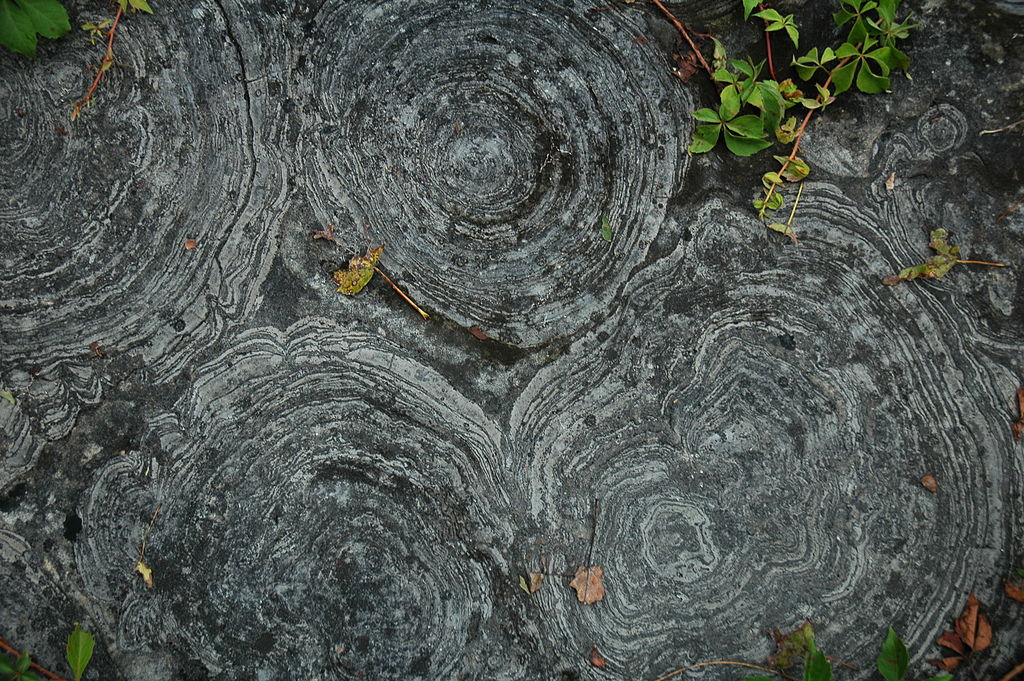Featured image: Cambrian stromatolites from New York State. Image attribution: James St. John / CC BY 2.0; Wikimedia Commons
Paper: Evidence for microbes in early Neoproterozoic stromatolites
Authors: Zhongwu Lan, Shujing Zhang, Maurice Tucker, Zhensheng Li, Zhuoya Zhao
Stromatolites are ancient, layered deposits of sediments that are characterized by thin, alternating light and dark bands. While microbial fossils have been found in many stromatolites, the biological origin of these structures has been debated.
It is not always clear whether microbes found in stromatolites were passively trapped in the sediments or if they contributed to the formation of the stromatolite structure (a process called “syndeposition”). In other words, were these ancient bacteria just along for the ride or did they help build these structures? Also, while even billion year old stromatolites are known to have fossilized microbial inhabitants, fossils from the Proterozoic era (2,500 – 541 million years ago) have been rare finds. Studying these ancient rock formations helps us answer all of these questions and the history and evolution of life on Earth, especially because microbial fossil records are hard to obtain by other means.

A new study conducted by an international team of researchers from China and the UK used Scanning Electron Microscopy (SEM) techniques to explore Neoproterozoic stromatolites from the Jiuliqiao formation in China, where worm-like macrofossils have previously been unearthed. A scanning electron microscope can produce high-resolution images by using electron beams instead of light beams (like a traditional microscope) to examine samples.
The first thing the team noticed was the characteristic dark and light layers that indicated the presence of microbes. A closer look revealed a multitude of shapes: filamentous ends like the ends of a rope, polygonal structures, and spheres of different sizes. The microbial filaments were the same color as and embedded in the host rock, which is a confirmation that these filaments were integral to the stromatolite’s structure. The SEM images revealed that the filaments were flexible enough to suggest that they had been intact and alive when the layers formed. Finally, the presence of organic (biologically derived) carbon adds weight to the idea of syndeposition in these sediments, especially since the stromatolite’s isotopic signature resembles that of early Proterozoic marine carbon compounds.
The filamentous and spherical shapes were identified as cyanobacteria, the nanospheres as virus-like particles, and the polygonal structures as EPS or extracellular polymeric substances, a type of natural polymer secreted by bacteria. The presence of virus-like spheroids is particularly interesting since they could have acted as tiny centres for the solidification of carbonate minerals and thus contributed to stromatolite formation.

All of these microbes seem to have acted together to build the stromatolite, although the key step would have been for the cyanobacterial filaments to bind sediments, organic matter and precipitated calcium carbonate. This process would have been aided by cyanobacterial EPS, which is quite adhesive. These microbial mats would then build upwards, using the first cyanobacterial layer as a base. Physical forces like gravity would adjust and settle the sediment particles and microbial filaments, producing jagged structures that show clear traces of compaction. Thus, stromatolite patterns can be indicative of the physical environment that accompanied their formation, and the Jiuliqiao stromatolites reflect changing tidal conditions over the years.
Such findings are rare in early Proterozoic stromatolites, and this study provides a visual snapshot of how prehistoric microbes interacted with the world around them. Clearly, we live in a world shaped by microbes and even tough, fossilized stromatolites are no exception to this rule.

Ancient microbes engineered sedimentary deposits by Janani Hariharan is licensed under a Creative Commons Attribution-ShareAlike 4.0 International License.

